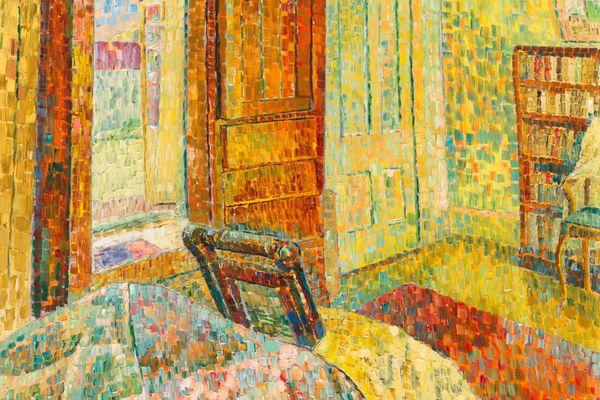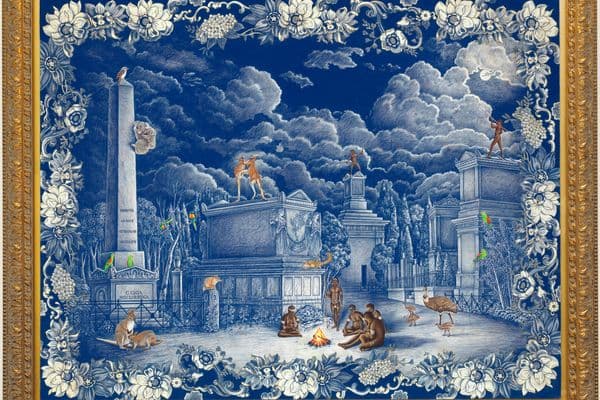Roy Lichtenstein

Roy Lichtenstein at Tyler Graphics Ltd., Bedford Village, New York, 1977
Gift of Kenneth Tyler 2002
Photographer: Kenneth Tyler
Roy Lichtenstein (1923–1997) worked with Ken Tyler at both his west and east coast workshops, beginning at Gemini GEL in 1969. The artist developed an original aesthetic during the early 1960s that paradoxically highlighted industrial printing methods derived from his sources of inspiration—the subject matter of popular culture. Paintings and prints were rendered to achieve a mass–produced look using the Ben Day dot system—named after the American illustrator Benjamin Day. This is a system where coloured dots on a white background give the appearance of a half tone. Other sources of inspiration for Lichtenstein were the art of Claude Monet, along with the early 20th–century art styles of Expressionism, Cubism and Art Deco.
In subsequent years working with Tyler, Lichtenstein liked to investigate the possibilities of combining printing techniques. In 1976 he completed the complex and innovative series Entablatures, which combined screenprinting, lithography, embossing and collage to produce a remarkable three–dimensional quality suited to his subject matter—architectural ornament.
In 1989–90 Lichtenstein and Tyler attempted a further technically complex series, Reflections, using mutiple techniques and collage. The prints are so large and complex that the various processes were pushed to the very limit, while demanding that the printer achieve perfect registration, without overlap, and keep the paper, with all its collage and embossing, intact. The series draws on the subjects first seen in Lichtenstein's work of the 1960s—the fighter pilots and blonde beauties of the cartoon strips—in one instance, Reflections on Scream, he refers to the work of Edvard Munch.
In Nudes 1994, the last prints that Lichtenstein made with Tyler, the artist reinterprets the type of comic strip imagery he first used in the 1960s. In these prints, it appears that Lichtenstein had turned full circle. But his treatment of the old subject matter is radically different. In these late works he has used a lighter palette and Ben Day dots of different sizes to create shading, traditionally known as chiaroscuro, to define form.
Jane Kinsman
Works in the Kenneth E. Tyler Collection
Browse all works by Roy LichtensteinFurther Reading
EXHIBITIONS
- Lichtenstein to Warhol, 2019–20
- Roy Lichtenstein: Pop Remix, 2012–13
- The Big Americans, 2002–03
- Roy Lichtenstein: Printworks, 5 April – 21 July 1996
- Back to the Future: International prints 1985–1991, 14 September – 15 December 1991
- Lasting Impressions: Lithography as art, part II, 18 June – 31 July 1988
- Print by Print, Step by Step: Artists’ Prints in Series, 9 March – 16 June 1985
- Ken Tyler: Printer extraordinary, 6 June – 13 October 1985
- Out of the Book and on to the Wall: The relief print, part II, 25 August – 28 October 1984
- Paperwork, 13 October 1982 – 16 May 1983
VIDEO
- Roy Lichtenstein
- Roy Lichtenstein: Entablature
- Roy Lichtenstein: Pop Remix
- Roy Lichtenstein: Reflections series
NATIONAL GALLERY PUBLICATIONS
- Lichtenstein to Warhol: The Kenneth Tyler Collection, Jane Kinsman, exhibition catalogue, 2019
- Workshop: The Kenneth Tyler Collection, Jane Kinsman (ed.), 2015
- Roy Lichtenstein: Pop Remix, Jaklyn Babington, exhibition catalogue, 2012
- The Art of Collaboration: The Big Americans, Jane Kinsman, exhibition catalogue, 2002
- Paperwork, Pat Gilmour and Anne Wilsford, exhibition catalogue, 1982
TYLER GRAPHICS PUBLICATIONS
- Nudes, 1994
- Reflections Series exhibition invite 1990
- Walking Through, Tyler Graphics Ltd. March, 1990
- Brushstrokes: Six Painted reliefs, 1986
- Entablatures, 1974
KENNETH TYLER ARCHIVE
- At Gemini, Cathedral and Haystack series 1969
- Brushstroke Figures exhibition invite, Glenn Dash Gallery, 1989
STORIES
RELATED LINKS











